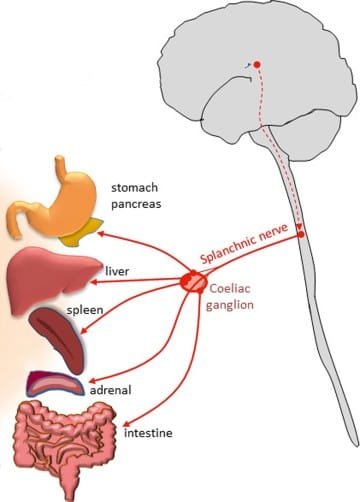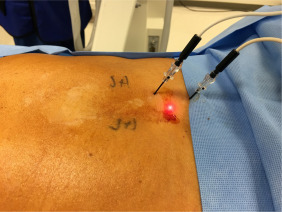Mitigate Pain Clinic – Dr Jeshnu Tople – Pain Management Specialist In Nagpur
Splanchnic Nerve RFA for Abdominal Pain
Splanchnic Nerve Radiofrequency Ablation
Effective Pain Relief for Abdominal Conditions
Introduction to Splanchnic Nerve RFA

What Are the Splanchnic Nerves?
How Splanchnic Nerve RFA Works


Conditions Treated by Splanchnic Nerve RFA
Splanchnic Nerve Radiofrequency Ablation is used to treat various abdominal pain conditions, including:
- Pancreatitis: A long-lasting condition causing severe inflammation and pain in the pancreas.
- Abdominal Cancer Pain: Pain resulting from tumors or cancers affecting the stomach, pancreas, liver or other abdominal organs.
- Chronic Abdominal Pain: Pain caused by a variety of gastrointestinal disorders that do not respond to traditional pain medications.
- Post-Surgical Abdominal Pain: Pain following surgeries such as pancreatic or gastric surgery.
Patients with conditions that lead to continuous abdominal pain often find relief through Splanchnic Nerve Ablation when other treatments have failed.
At Mitigate Pain Clinic, we will conduct a thorough evaluation, including medical history, physical examination and if required diagnostic tests, to determine if Splanchnic Nerve Radiofrequency Ablation is the right choice for you.
Preparing for Splanchnic Nerve RFA
Preparation for the procedure is relatively simple. You will likely be advised to:
- Stop taking blood thinners a few days before the procedure.
- Avoid eating or drinking for a few hours before the procedure.
- Arrange for transportation, as you will not be allowed to drive back home.
- Diagnostic splanchnic nerve block is usually required a day prior to the radiofrequency ablation.
Our team at Mitigate Pain Clinic will provide you with detailed pre-procedure instructions to ensure the process goes smoothly.
The Procedure: What to Expect
Splanchnic Nerve RFA is typically performed on day-care basis and involves the following steps:
- Preparation: You will lie on your stomach and the doctor will use imaging, usually fluoroscopy to locate the splanchnic nerves.
- Local Anesthesia: Local anesthetic will be applied to the skin to numb the area where the needle will be inserted.
- Needle Insertion: A thin needle is inserted through the back into the area near the splanchnic nerves.
- Radiofrequency Ablation: Once the needle is in place, radiofrequency energy is delivered to heat the nerve tissue, creating a small lesion that blocks pain signals.
Post-Procedure: After the procedure, you will be monitored for a short time before being discharged to go home.The entire procedure typically takes around 60 minutes and most patients can return home the same day.


Benefits of Splanchnic Nerve RFA
There are several benefits to choosing Splanchnic Nerve RFA at Mitigate Pain Clinic:
- Long-Lasting Pain Relief
- Minimally Invasive requiring only needle prick
- Reduced Medication Dependency
- Improved Quality of Life
- Personalised Care
Potential Risks and Side Effects
As with any medical procedure, there are risks associated with Splanchnic Nerve Radiofrequency Ablation, although serious complications are rare. Possible side effects include:
- Temporary pain at the injection site
- Soreness where the needle was inserted
- Temporary diarrhea or low blood pressure
At Mitigate Pain Clinic, we take great care to minimize any potential risks and will monitor you closely during and after the procedure.